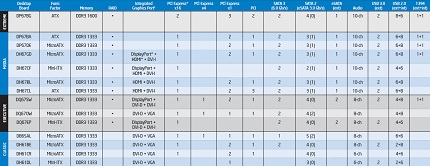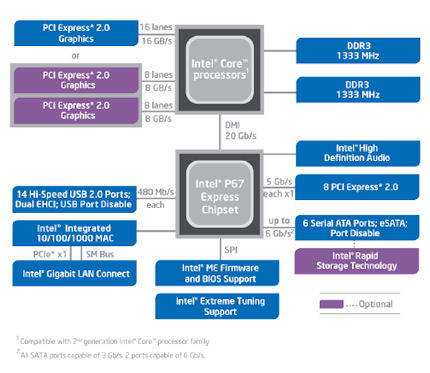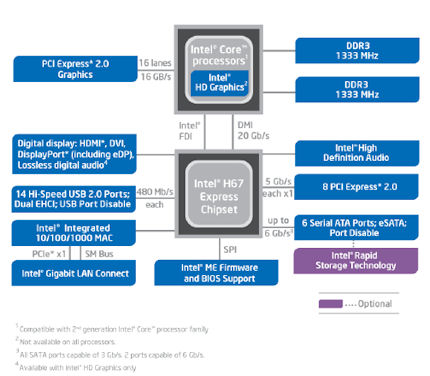Great chips, but new chipsets required
So you've seen Sandy Bridge's mojo and want one. They start at below £100 and have both CPU and GPU goodness baked into each and every chip. Good deal, right?
Trouble is, Intel sees the introduction of a new architecture as an opportune time to change the chip's pin layout and, consequently, motherboard chipset. Sandy Bridge chips move from the LGA1156 of mid-range Intel processors to an LGA1155 socket. This means that no Sandy Bridge processor will operate in any existing motherboard. Rather, they need some accompanying love from the all-new 6-series chipset.
This Intel-provided matrix shows that Sandy Bridge (desktop) is supported by three main chipsets - P67, H67 and Q67 - as well as two cheaper chipsets destined for the OEM market, the B65 and H61. The nomenclature is in line with incumbent Intel chipsets, and we expect motherboard partners to fill their boots with a wide range of boards, particularly with reference to P67 and H67.
Mind your Ps and Hs
Providing consistency through series, the H-series board provides support for outputting the integrated graphics from Sandy Bridge's IGP core, while the P-series chipset requires a discrete graphics card but offers more in the way of features - at least when manufacturers have finished with it.
Here's the P67 in block-diagram form:
As should be abundantly clear by now, Intel packages up practically all the processing in the chip itself. Official dual-channel memory support remains at 1,333MHz, though the likes of ASUS and Gigabyte should offer P67 boards that get around this limitation.
Graphics are provided by way of an add-in card or two. A single card receives the full x16 PCIe 2.0 bandwidth, while a couple of cards are assigned x8 lanes each. P67 supports both AMD's CrossFire and NVIDIA's SLI right off the bat.
SATA 6Gbps in the chipset
Sandy Bridge silicon is connected to the chipset - well, single chip - via the usual 2GB/s DMI link. Now, P67 is a little more feature-packed than the P55 shipping last year. First off, it provisions for SATA 6Gbps, which is useful when running super-fast SSDs, especially in RAID. It's the first time that the standard has been integrated into an Intel 'southbridge', and we believe that most partner boards will feature at least a couple of SATA 6Gbps-compliant ports on top of the four standard 3Gbps connections.
Expansion is taken care of by up to 8 PCIe 2.0 lanes. Intel provides Gigabit Ethernet on its range of desktop boards, though partners may well choose cheaper options from Realtek and Marvell, hanging off the PCIe lanes. What's conspicuous by its absence is chipset-integrated USB 3.0, so we'll see the usual array of NEC USB 3.0 controllers riding off further PCIe lanes.
Really, P67 isn't a huge leap over P55, save for SATA 6Gbps support. The chipset is simply needed to provide the backbone from which to power the Sandy Bridge silicon.
H67 - routing out graphics
Matters are a tad more interesting with the H67 chipset. Remember, it exists to provide a means by which the Intel HD Graphics are output to an external monitor. Intel's Flexible Display Interface (FDI) is the same display conduit as on present H55 boards. However, Sandy Bridge graphics now have a built-in DisplayPort interface that complements the HDMI and DVI - single-link, mind - outputs we've come to see on IGP-laden boards.
The exact digital video outputs on retail boards will be at the partner's discretion. Taking Intel's own chart - at the top of this page - as a base, DisplayPort will only be present on higher-end motherboards, which will be split between microATX and miniITX form factors.
Improvements over LGA1156 (H55) boards seem incremental, but a chipset's job is to route out the features in the most-economical way possible. Intel reckons it has made large strides in enhancing the quality of the processor graphics, enough to make H67 boards an interesting proposition in their own right, especially for users contemplating a small, quiet home theatre PC.












